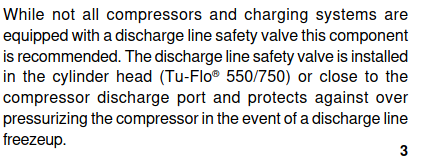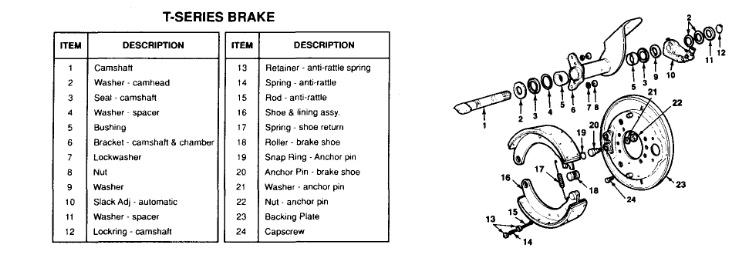
Geoff Weeks
Pedigreed Bulldog-
Posts
2,194 -
Joined
-
Last visited
-
Days Won
7
Content Type
Profiles
Forums
Gallery
Events
Blogs
BMT Wiki
Collections
Store
Everything posted by Geoff Weeks
-
Air compressor question e7
Geoff Weeks replied to mcratchet1's topic in Modern Mack Truck General Discussion
Bendix's method of timing the time the compressor is compressing vs off time is the most accurate. It is hard to tell when the compressor starts compressing esp sitting in the driver seat. Timing the time between drier blow-off rolling down the road at a constant highway speed is a good approximation, and easy to hear from the drivers seat on most trucks. You can also watch the pressure gauges. If the go to cut-out pressure and never move, but the drier keeps cycling, the leak is between the compressor and wet tank (inclusive). If one gauge drops to cut-in while the other stays higher, then look at that side of the duel line system. If both drop, (esp if towing a trailer) it could be the trailer that is leaking. All trailers are "single line" brake system that can be fed from either the primary or secondary side of the tractor brakes. -
Air compressor question e7
Geoff Weeks replied to mcratchet1's topic in Modern Mack Truck General Discussion
Ahh, that is what you are going to have to find. My best truck, air ride truck, air ride trailer, air wipers, air start, fully loaded on the interstate would go 45 min between blow off of the air drier. My worse truck was around 15-20 min. The differance between the two most likely had to do with the best used nylon air tubing and the other used airquip hose. Every hose, every fitting and valve are potential leaks. Not a fun job tracing them all down. Bendix says 25% duty cycle, meaning the compressor is compressing 25% of the time MAX. (high use is 25% low use is 15% between those two is normal) That is you time the when the compressor starts compressing till when it stops, then time to when it starts again. Put the 1st number of minutes over the 2nd and the result should be less than 0.2. Stop and go driving is going to use more air, but if you compressor is already struggling to keep the system up, it will be running continuously in stop and go traffic. You'll notice that intake pipe is clamped to the rear head to keep it tight to the fittings at each end. Your pictures don't show a tube/pipe anywhere near the head. -
Air compressor question e7
Geoff Weeks replied to mcratchet1's topic in Modern Mack Truck General Discussion
You need to look at the whole truck. Ready to roll (brakes off) engine at speed. I bet that 2-3 min drops to less than a min at 1800 rpm. -
Air compressor question e7
Geoff Weeks replied to mcratchet1's topic in Modern Mack Truck General Discussion
Not exactly, What they show is a tube that is butted up at each end, then a short piece of hose that seals the two together The amount of exposed hose to the pressure is minimal, not the same as your pictures where there is a long section of hose. Still I would use silicone Radiator hose (rigid hose) to make the joint. You also have a clearance issue with another hose which will rub through the heater hose. New piping, new correct hose. Any compressor will pass oil if its duty cycle is high. A brand new one (not rebuilt) will. So 1st assess the condition of the air system before looking at replacing the compressor. There have been people on this board who have replaced compressors more than once with no gain, because the compressor is always loaded. Time your compressor cycles going down the highway, if the compressor doesn't go 15 min between cycles, you have work to do. -
I always used Interstate-Mcbee for Cummins but they have nothing for older Mack. I tried a few PAI gauges, I think IHC an Mack used the same, anyway, The PAI were crap, I ended up taking them apart and only using the rear housing, re installing the OEM in the housing. Took a little work, but worth it in the end. I think I tried a few door latches that were PAI also. I hope their engine parts are better.
-
Air compressor question e7
Geoff Weeks replied to mcratchet1's topic in Modern Mack Truck General Discussion
Heater hose can only be used if the intake of the compressor is connected to the trucks air cleaner (non pressurized). For those connected to the intake (pressurized on a turbo engine) a hose rated for pressure and temp needs to be used. I had some thick multi braid hose that "looked" like heater hose at a glance that worked well. rated for 300 psi and high temp. Where it has to go around the head, tubing with short connector hose would be best. Steel or aluminum tube bent to fit with a bead to hold the hose at each end. That way, no chance of "kinking" the hose. -
Air compressor question e7
Geoff Weeks replied to mcratchet1's topic in Modern Mack Truck General Discussion
You got it backwards, the compressor intake is being boosted from the engine. -
Eaton versus Meritor Rockwell Transmissions
Geoff Weeks replied to farmer52's topic in Engine and Transmission
I looked at it like this: Eaton made close ratio main box with repeatable shift pattern, wide ratio range box. Spicer made wide ratio main box with close ratio splitters, with a non repeat shift pattern What did Meritor bring to the table that was better or different? -
Eaton versus Meritor Rockwell Transmissions
Geoff Weeks replied to farmer52's topic in Engine and Transmission
Page 116 shows the isolator, just like Eaton. Meritor parts -
Eaton versus Meritor Rockwell Transmissions
Geoff Weeks replied to farmer52's topic in Engine and Transmission
There are likely 2000 Eaton's for every 1 Meritor. For parts alone, your better off with what everybody else has. Neighbor had one, I don't know what the problem was but he complained a lot about it. Both are a box of gears, and put together much the same way. Look at the stick right above where it goes into the transmission for an isolator bushing. -
my bad, sorry, I read it as "I got 6 of these". Age enhanced reading, Sometimes it leads to funny results.
-
hopefully you got your pictures messed up because that is the same part number you had before, P-2 not P20
-
Both my air start units came from Manders, also my aluminum air start tank to replace one of the steel ones that rusted. They have some interesting stuff sometimes.
-
1972 Loadstar , my love for loadstars continues .
Geoff Weeks replied to 85snowdog's topic in Other Truck Makes
That would be the heavier end of the Loadstar line 1800. Air braked? I think I see an air tank, but could also be for vacuum storage. -
E3 to E6 trendle valve
Geoff Weeks replied to treefroggs's topic in Antique and Classic Mack Trucks General Discussion
I wouldn't try to plug off ports. It is designed to balance the force between the two halves. If you are hell bent on using an E 6 in place of an E-3 then parallel the two sides so both feed the single outlet. If you are trying to go the other way, replacing a 6 with a 3, then there is no way and it would be a red-tag at inspection if you did. Just like single vs tandem master cyl on car brakes. -
seeing the paint burned off the tube at the bend behind the compressor, make worry about some "coking" in the discharge line. I would remove and clean or replace to be sure of it. I kept a very close eye on my air system and rarely if ever had a problem. I don't think any of my trucks had a relief before the drier, all had them at the drier.
-
-
The earlier compressors in the Tru-Flo series, TF500,600, 700 and TF501 I don't think had the provision for a relief the TF 550 I believe does. It is a later compressor. I still have some 500 and 700 models, I'll have to check if I have a 501.
-
P.S. glad it worked for you. disconnecting the line and running at high speed is kind of a "hail Mary" type situation, may work, but sort of last ditch effort before pulling the compressor.
-
I don't think the TF501 has that. Replace the elbow from the tube with a T fitting and a pipe to flare adapter and put the relief valve there. Also inspect or replace the copper line. If the head had carbon build up good chance the copper line does also. Be sure to use a high temp relief valve as the outlet temp can be quite hot
-
Here is a link to the manual, but they barely mention the T brake. Brake manual
-
They are "obsolete" but I liked them better than the Q's because they held the shoe in position better with the pin and loop on the bottom end. My 1989 had them but it was likely the last year to use them. The "nail and spring" are just there to hold the shoe against the backing plate. There shouldn't be a whole lot of force, just enough to prevent the shoe from "rattling" against the plate when the brakes are released. The above diagram doesn't show two spring on the nail, only one. One is all I have seen also.
-
I just saw you have spring between the backing plate and the shoe as well as on the shoe to cap side. I have never seen spring on the "inside" the shoe rested on pads on the backing plate, much like a car does. So only one spring on each "nail".
-
Looks right to me.
-
these are the type with a pin (loop) at the bottom and a single return spring across the cam end, with "brake nails" mid way that have a spring and a retainer that you compress and make a 1/4 turn correct? I have had problems with the nails/retainers not being right. Other than that, they are like old drum brakes on cars, not much to them. Photo of the problem might help.
BigMackTrucks.com
BigMackTrucks.com is a support forum for antique, classic and modern Mack Trucks! The forum is owned and maintained by Watt's Truck Center, Inc. an independent, full service Mack dealer. The forums are not affiliated with Mack Trucks, Inc.
Our Vendors and Advertisers
Thank you for your support!







